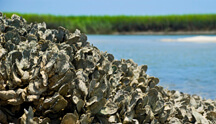Purdue researcher cracks open secret of oysters' ability to stick together

An oyster reef in the Baruch Marine Field Laboratory on the South Carolina coast. (Photo courtesy of Jonathan Wilker/Purdue University)
WEST LAFAYETTE, Ind. - A Purdue University-led research team has uncovered the chemical components of the adhesive produced by oysters, providing information that could be useful for fisheries, boating and medicine.
A better understanding of oysters' ability to stick together to form complex reefs would help those trying to boost the dwindling oyster population, aid in the creation of materials to keep boat hulls clean without harming the environment, and bring researchers one step closer to creating wet-setting adhesives for use in medicine and construction.
Jonathan Wilker, a Purdue professor of chemistry and materials engineering, led the team that analyzed the most common oyster in the United States, Crassostrea virginica, known as the common Eastern oyster. A paper detailing the work is published in the current issue of the Journal of the American Chemical Society.
"With a description of the oyster cement in hand, we may gain strategies for developing synthetic materials that mimic the shellfish's ability to set and hold in wet environments," said Wilker, who has worked on the design of synthetic bioadhesives for more than 10 years. "Dentistry and medicine may benefit from such a material. For instance, it would be great to have a surgical adhesive that could replace staples and sutures, which puncture healthy tissue and create potential sites for infection."
By comparing oyster shells with the material that connects the animals to each other, the researchers were able to determine its chemical composition. The results showed that the adhesive had almost five times the amount of protein and more water than what is found in the shell.
"The adhesive material differed significantly in composition from the shell, which indicates that the oyster produces a chemically distinct substance for sticking together," Wilker said.
Wilker, who also studies mussel and barnacle adhesion, describes the oyster adhesive as more of an inorganic cementlike substance than the organic gluelike material produced by other marine animals.
"The oyster cement appears to be harder than the substances mussels and barnacles use for sticking to rocks," he said. "The adhesives produced by mussels and barnacles are mostly made of proteins, but oyster adhesive is about 90 percent calcium carbonate, or chalk. On its own, chalk is not sticky. So the key to oyster adhesion may be a unique combination of this hard, inorganic component with the remaining 10 percent of the material that is protein."
This 10 percent of oyster cement does bear some similarity to mussel glue in its composition of proteins and the presence of iron.
In earlier studies Wilker found that iron played a key role in the hardening, or curing, of mussel adhesive, and it may serve a similar purpose in the oyster adhesive, he said.
Finding common threads in the sticky substances produced by marine organisms is key to the development of both synthetic adhesives and treatments to prevent the accumulation of these animals on ships.
Hundreds of different marine species attach themselves to ships, increasing drag and reducing sailing speeds. Preventing and controlling their accumulation, called fouling, is a major expense for the world's shipping fleet, Wilker said.
"The current antifouling methods rely on toxicity and ship bottoms are often coated with a copper-based paint that kills marine organisms in their larval states," he said. "If we could figure out a non-toxic a way to defeat the adhesives, we could keep them off ships without harming the environment."
Oysters stick together to reproduce and to protect themselves from predators and large waves. The reefs can stretch for miles and filter large volumes of water, prevent erosion and create a storm wall that strengthens coastlines. In addition, the reefs create a habitat for hundreds of other species, Wilker said.
"Overfishing, pollution and disease have reduced the oyster population by 98 percent or more since the late 1800s," he said. "Many people are now trying to reintroduce the animals to their prior habitats. Perhaps our work will add to the understanding of this shellfish and what is needed for oysters and the larger coastal ecosystem to thrive."
The Office of Naval Research and the National Science Foundation funded this research. Co-authors of the paper include Purdue graduate students Jeremy Burkett and Lauren Hight, and Paul Kenny of the Baruch Marine Field Laboratory at the University of South Carolina.
Wilker and his team will next investigate the interaction of the different components within oyster cement and use this information for developing new synthetic materials.
Writer: Elizabeth K. Gardner, 765-494-2081, ekgardner@purdue.edu
Joshua A. Chamot, National Science Foundation, 703-292-7730, jchamot@nsf.gov
Related websites:
NSF news release: https://www.nsf.gov/news/news_summ.jsp?cntn_id=117578
ABSTRACT
Oysters Produce an Organic-Inorganic Adhesive for Intertidal Reef Construction
Jeremy R. Burkett, Lauren M. Hight, Paul Kenny, and Jonathan J. Wilker
Coastal ecosystems rely upon oyster reefs to filter water, provide protection from storms, and build habitat for other species. From a chemistry perspective, few details are available to illustrate how these shellfish construct such extensive reef systems. Experiments presented here show that oysters generate a biomineralized adhesive material for aggregating into large communities. This cement is an organic-inorganic hybrid and differs from the surrounding shells by displaying an alternate CaCO3 crystal form, a cross-linked organic matrix, and an elevated protein content. Emerging themes and unique aspects are both revealed when comparing oyster cement to the adhesives of other marine organisms. The presence of cross-linked proteins provides an analogy to mussel and barnacle adhesives whereas the high inorganic content is exclusive to oysters. With a description of oyster cement in hand we gain strategies for developing synthetic composite materials as well as a better understanding of the components needed for healthy coastal environments.
